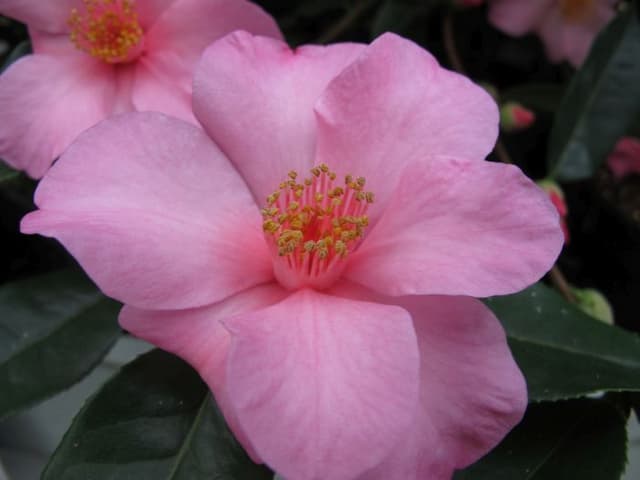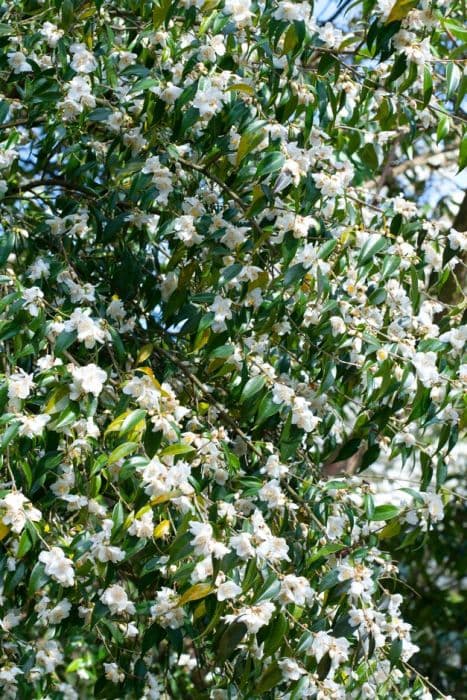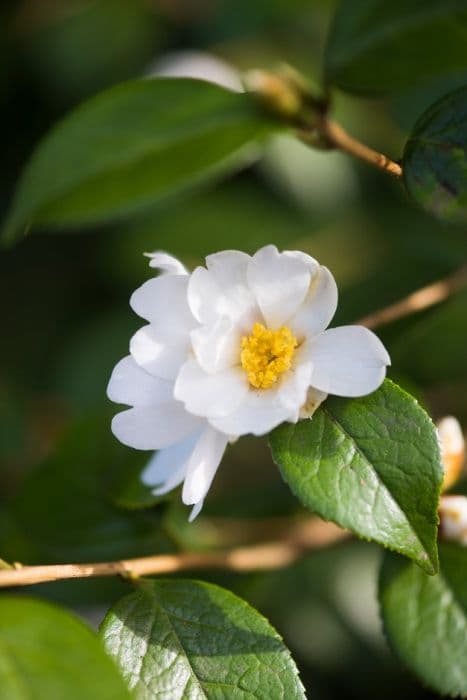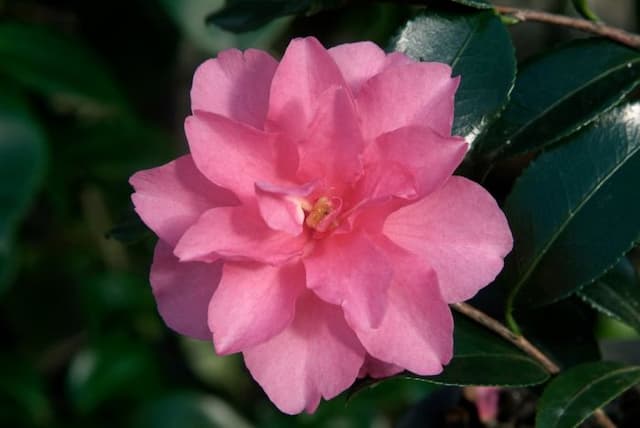Japanese Camellia Camellia japonica 'Apple Blossom'

ABOUT
The Camellia japonica 'Apple Blossom' is an ornamental shrub known for its striking floral display and glossy, evergreen foliage. The leaves are a deep green color, oval in shape with edges that are finely serrated, giving them a nuanced texture and an elegant outline that complements the flowers. The blossoms of the 'Apple Blossom' variety are particularly charming and resemble that of apple blossoms, hence the name. The flowers are delicate and showy, featuring soft pink petals that lighten towards the edges, gracefully intermingling with petals that have shades of creamy white, creating a subtle, blush-tinted effect. These exquisite flowers have a classic, layered form, often described as peony-like or semi-double, which means that they have more than one row of petals, but not so many that they form a solid, rounded dome. In the center of each flower, the contrast between the light petals and the cluster of prominent golden-yellow stamens adds a touch of brightness, attracting pollinators and providing a captivating visual focal point. The Camellia japonica 'Apple Blossom' is frequently grown for its generous bloom season and robust, yet elegant, appearance, making it a popular choice for gardens and landscapes where a touch of delicate color is desired. With attentive care, this plant becomes a lush, vibrant part of the garden, celebrated for its beautiful flowers that signal the arrival of spring.
About this plant
 Names
NamesFamily
Theaceae
Synonyms
Japanese Camellia, Rose Of Winter
Common names
Camellia japonica 'Apple Blossom'.
 Toxicity
ToxicityTo humans
Camellia japonica, commonly known as the Japanese camellia, is not considered toxic to humans. It does not typically cause poisoning or adverse symptoms if ingested.
To pets
Japanese camellia is generally considered non-toxic to pets as well. It is not known to cause poisoning or produce harmful symptoms if pets ingest parts of this plant.
 Characteristics
CharacteristicsLife cycle
Perennials
Foliage type
Evergreen
Color of leaves
Dark green
Flower color
Pink
Height
6-10 feet (1.8-3 meters)
Spread
6-10 feet (1.8-3 meters)
Plant type
Shrub
Hardiness zones
7-9
Native area
Japan
Benefits
 General Benefits
General Benefits- Aesthetic Appeal: Camellia japonica 'Apple Blossom' adds visual interest to gardens with its delicate pink and white flowers that resemble apple blossoms.
- Seasonal Interest: It blooms in late winter to early spring, providing color during a time when many other plants are dormant.
- Landscape Versatility: This plant can be used in various landscape applications, including as a specimen plant, in borders, or as part of a foundation planting.
- Evergreen Foliage: The plant retains its glossy, dark green leaves throughout the year, offering continuous foliage even when not in bloom.
- Wildlife Attraction: Its flowers can attract hummingbirds and other pollinators to the garden, which is beneficial for the local ecosystem.
- Low Maintenance: Once established, Camellia japonica 'Apple Blossom' requires relatively little care, making it suitable for gardeners of all skill levels.
- Longevity: Camellias are known for their long life span, and with proper care, they can thrive for many years, adding consistency to the landscape.
- Privacy Screening: With its dense growth habit, it can function as an effective privacy screen or hedge, creating secluded areas within a garden or landscape.
- Tolerant of Partial Shade: Unlike some other flowering plants, it can bloom even in partial shade, making it a valuable addition to shaded garden areas.
 Medical Properties
Medical PropertiesThis plant is not used for medical purposes.
 Air-purifying Qualities
Air-purifying QualitiesThis plant is not specifically known for air purifying qualities.
 Other Uses
Other Uses- Crafting Bonsai: Camellia japonica 'Apple Blossom' branches can be trained to form artistic bonsai arrangements that create a miniaturized yet natural representation of a tree.
- Leaf Shine: The glossy leaves of Camellia japonica 'Apple Blossom' are sometimes used by florists to create a natural shine in their floral arrangements.
- Photography Backdrops: Full bushes of Camellia japonica 'Apple Blossom' can provide an attractive spring-themed backdrop for outdoor photography.
- Edible Decorations: Although not commonly consumed, the petals of Camellia japonica 'Apple Blossom' can be used as delicate edible garnishes for salads and desserts after proper verification for non-toxicity.
- Therapeutic Horticulture: Gardening Camellia japonica 'Apple Blossom' might be used as a form of therapeutic horticulture for improving mental health through the nurturing of plants.
- Handmade Paper: The fibrous material from Camellia japonica 'Apple Blossom' can be incorporated into handmade paper, adding a unique texture and floral elements.
- Dye Source: The petals of Camellia japonica 'Apple Blossom' could potentially be used to extract natural dyes for fabric or craft projects.
- Scrapbooking Embellishments: Dried Camellia japonica 'Apple Blossom' flowers can be used for decorating scrapbooks or making greeting cards.
- Perfumery: While not a common use, the subtle fragrance of Camellia japonica 'Apple Blossom' flowers may inspire natural perfume blends.
- Plant-Based Inks: The pigments derived from the petals of Camellia japonica 'Apple Blossom' might be explored for creating plant-based inks for art or writing.
Interesting Facts
 Feng Shui
Feng ShuiThe Camellia is not used in Feng Shui practice.
 Zodiac Sign Compitability
Zodiac Sign CompitabilityThe Camellia is not used in astrology practice.
 Plant Symbolism
Plant Symbolism- Adoration: Camellias often represent deep affection and adoration, making them a perfect gift to express admiration for someone.
- Perfection: Due to their exquisite beauty, camellias symbolize the pursuit of perfection in every aspect of one's life.
- Longevity: Camellias are known for their longevity both as a plant and in their blooms, representing enduring and steadfast life.
- Faithfulness: Similarly to many flowers, the camellia can symbolize faithfulness in a relationship due to its long-lasting nature.
- Refinement: The camellia's elegant appearance has made it a symbol of refinement and perfection in societies that favor these qualities.
 Water
WaterThe Camellia, or specifically the Camellia japonica 'Apple Blossom', should be watered deeply and thoroughly to encourage a strong root system, usually receiving about 1 inch of water per week. Watering frequency should be adjusted based on weather conditions, more frequently during dry spells and less during periods of rain. Overhead watering should be avoided to minimize the risk of leaf problems; instead, water at the base of the plant. A good rule of thumb for established plants is to water once a week, providing about 1 to 1.5 gallons per plant, ensuring the soil remains moist but not soggy.
 Light
LightCamellias such as 'Apple Blossom' thrive best in partial shade, particularly in a spot that receives morning sun and afternoon shade to protect the flowers and leaves from the harsh midday sun. An ideal location would be under the canopy of larger trees that offer dappled sunlight, as too much shade can result in fewer blossoms, while too much direct sun can lead to scorching of the leaves and flowers.
 Temperature
TemperatureThe Camellia 'Apple Blossom' prefers a temperate climate with temperatures ranging between 40 to 85 degrees Fahrenheit for ideal growth. It is hardy to a minimum temperature of approximately 20 degrees Fahrenheit. To protect the plant from cold injury, avoid planting in spots where cold air settles or frost pockets might form.
 Pruning
PruningPrune the Camellia 'Apple Blossom' to remove dead or weak wood and to shape the plant, ideally right after blooming has finished since camellias set their flower buds for the next year shortly after the previous bloom. Pruning once a year is typically sufficient. Selective trimming can also help increase air circulation and sunlight penetration to the plant's interior, promoting healthier growth.
 Cleaning
CleaningAs needed
 Soil
SoilJapanese Camellia 'Apple Blossom' thrives in acidic, well-draining soil with a pH between 5.5 and 6.5. The best soil mix is one part peat moss, one part pine bark, and one part perlite or coarse sand. This composition ensures proper drainage and maintains the necessary acidity.
 Repotting
RepottingJapanese Camellia 'Apple Blossom' generally requires repotting every 2 to 3 years. It's best to repot in the spring before the growing season begins, using soil with the same composition and pH requirements as mentioned above.
 Humidity & Misting
Humidity & MistingJapanese Camellia 'Apple Blossom' prefers high humidity levels, typically between 50-60%. To maintain proper humidity, you can use a humidifier, mist the leaves regularly, or place the pot on a pebble tray with water.
 Suitable locations
Suitable locationsIndoor
Provide bright, indirect light and keep soil slightly moist.
Outdoor
Plant in dappled shade with shelter from strong winds.
Hardiness zone
7-9 USDA
 Life cycle
Life cycleThe life of Camellia japonica 'Apple Blossom', commonly known as the Apple Blossom Camellia, begins with seed germination, which requires warm and moist conditions. After germination, the seedling stage is characterized by the development of a small set of true leaves. As it matures into a young plant, it undergoes vegetative growth, forming a shrub-like structure with glossy, dark green leaves. Once the plant reaches maturity, which may take several years, it enters the flowering stage, typically in late winter to early spring, producing delicate pink and white blossoms resembling apple blossoms. After pollination, the flowers develop into seed pods that, when mature, release seeds to start the next generation. During its life, the plant may also be propagated vegetatively through cuttings, which are often used to maintain desired cultivar characteristics.
 Propogation
PropogationPropogation time
Spring-Early Summer
Camellia japonica 'Apple Blossom', commonly referred to as the Apple Blossom Camellia, is predominantly propagated through semi-hardwood cuttings. The best time to take these cuttings is in late summer to early fall, after the plant has completed its growth cycle for the season and the current year's growth has begun to harden. The process involves taking cuttings of about 4 to 6 inches (approximately 10 to 15 cm) in length, with several leaves left at the top. The lower end is then dipped in a rooting hormone to encourage root development. These cuttings are then placed in a well-draining medium, such as a mix of peat and perlite, kept moist but not overly wet, and covered with plastic to maintain high humidity around the leaves. With appropriate warmth and indirect sunlight, the cuttings typically root within 6 to 8 weeks, after which they can be potted individually and gradually acclimatized to less humid conditions.









